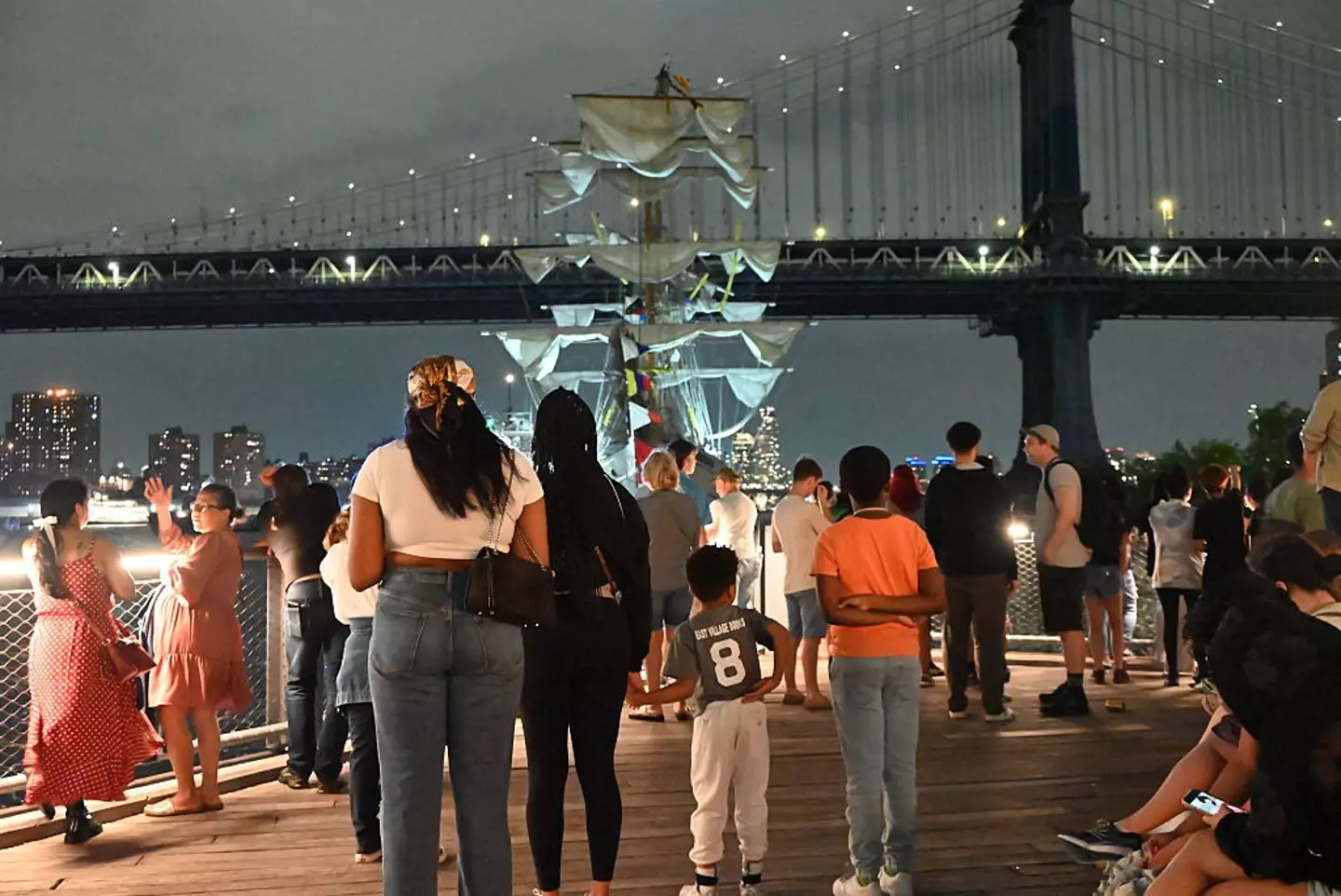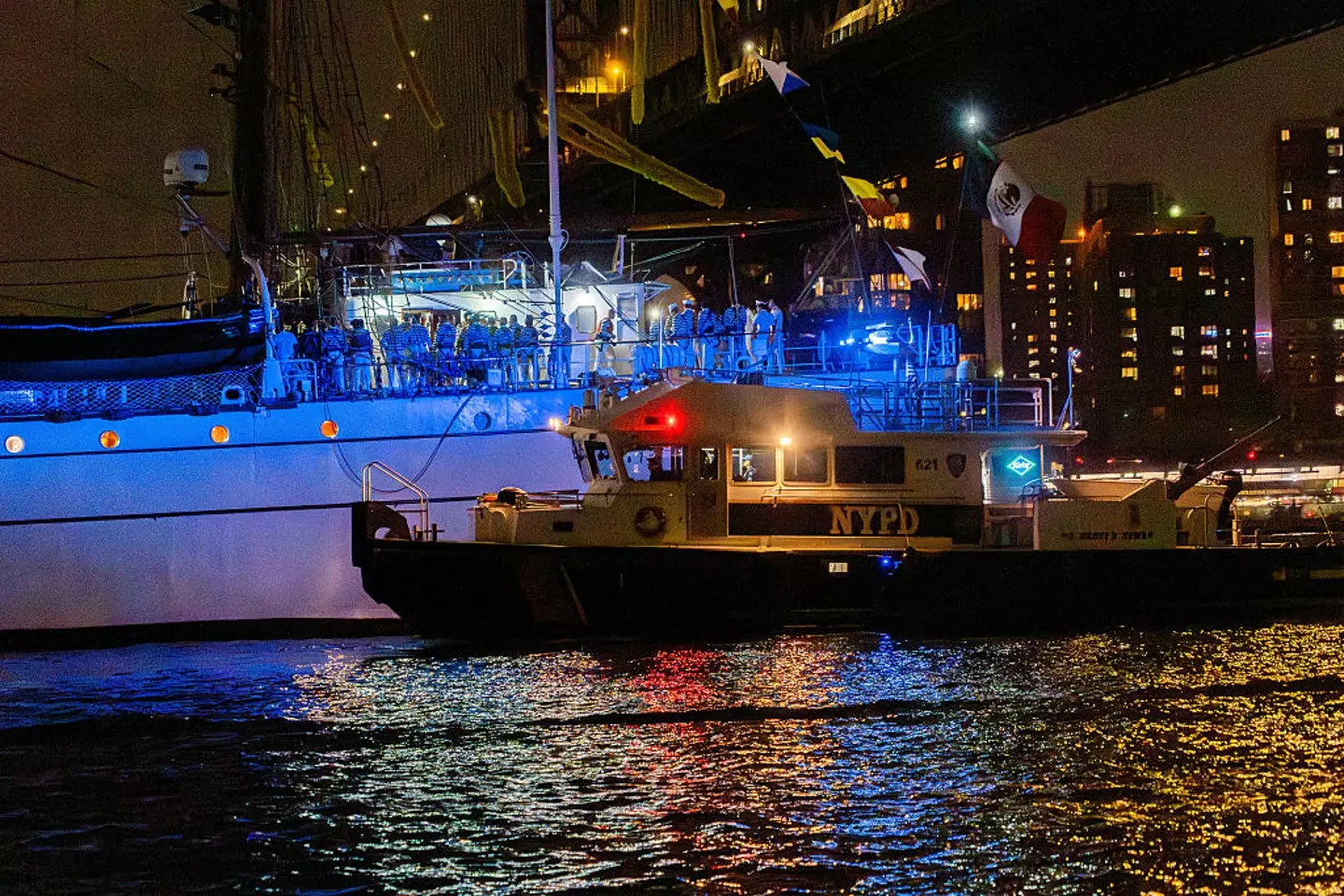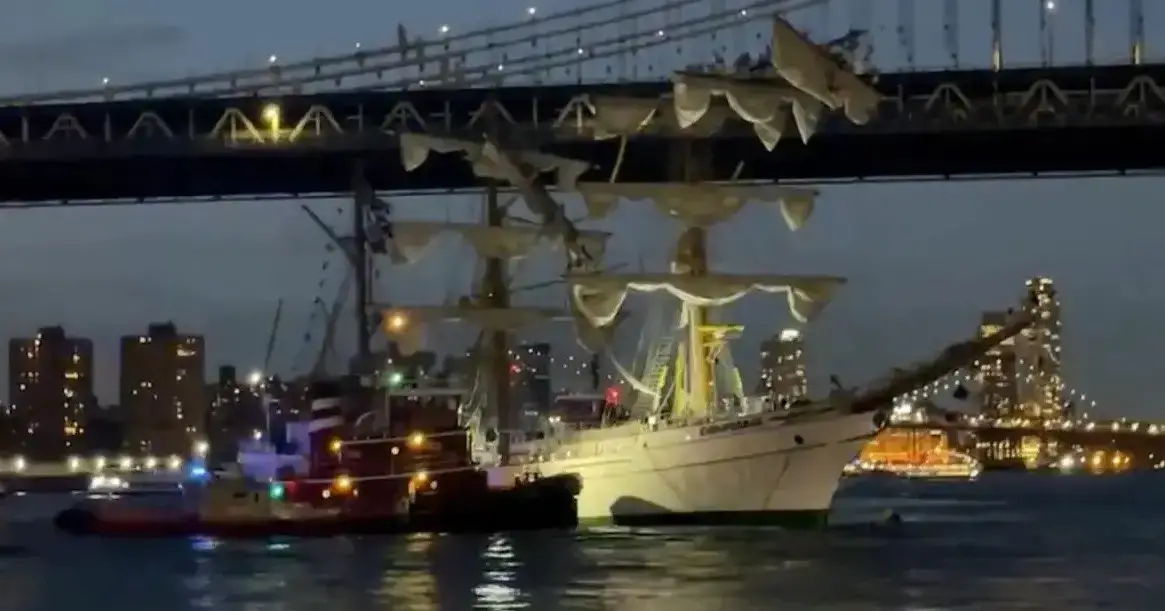A Detailed Account of the Cuauhtémoc’s Collision with the Brooklyn Bridge
On the evening of May 17, 2025, New York City bore witness to a catastrophic and highly unusual maritime accident: the Mexican Navy’s tall ship Cuauhtémoc smashed into the iconic Brooklyn Bridge, resulting in two fatalities and leaving 19 others injured. The vessel, carrying 277 cadets and crew members as part of a goodwill training mission, was navigating the East River when a sudden mechanical failure caused it to lose propulsion. Unable to clear the bridge’s span, the ship’s towering masts collapsed onto the roadway below. What follows is a comprehensive, professional overview of the incident—its sequence of events, immediate aftermath, ongoing investigation, and broader implications for maritime safety in major urban waterways.

1. Chronology of the Incident
-
Departure and Early Course
-
Around 6:30 PM, the tall ship Cuauhtémoc departed its Manhattan berth, bound for a scheduled tour of New York Harbor and the East River. Under clear skies and calm currents, the vessel steamed northward, with cadets on deck enjoying an evening training exercise.
-
-
Approach to the Brooklyn Bridge
-
By 8:15 PM, the ship approached the narrow corridor beneath the Brooklyn Bridge. Although it was not part of the vessel’s planned route, navigational adjustments—likely to showcase the ship against one of New York’s most famous landmarks—brought it inexplicably close to the bridge’s center span.
-
-
Mechanical Failure and Loss of Power
-
At approximately 8:20 PM, as the Cuauhtémoc attempted to pass under the bridge, its propulsion system suffered a sudden malfunction. Witnesses reported that the ship “went dead in the water,” losing steering and thrust simultaneously. Without engine power, the vessel began drifting with the current toward the bridge’s piers.
-
-
Collision and Mast Collapse
-
The ship’s main and mizzen masts—each extending well above the bridge’s clearance limit—struck the underside of the railway and pedestrian spans. Under tremendous force, the masts shattered and collapsed, sending rigging and spars crashing down onto the bridge deck and into the river. Two crew members, standing aloft when the impact occurred, tragically fell from the rigging and later succumbed to their injuries. An additional 19 individuals sustained trauma ranging from fractures and lacerations to head and spinal injuries; two remain in critical condition.
-
-
Emergency Response
-
Within minutes, New York City’s Emergency Medical Services, Fire Department, and NYPD converged on the scene. Floating cranes and the city’s marine unit helped stabilize the vessel and retrieve debris. Injured crew were triaged on the riverwalk and ferried to nearby hospitals. By 9:30 PM, the Brooklyn Bridge was closed to all traffic, and divers began searching the river below for any additional victims or debris.
-
2. Official Statements and Immediate Actions

2.1 New York City Authorities
-
Police Commissioner Wilson Aramboles provided the first public account of the evening’s events, confirming that the Cuauhtémoc “strayed from its intended course” after departure from Manhattan. He attributed the collision to a sudden mechanical failure that left the ship powerless under the bridge, necessitating an emergency response to prevent further loss of life.
-
Mayor Eric Adams released a statement via social media at 11:00 PM:
“Tonight, the Mexican Navy’s training vessel Cuauhtémoc experienced a catastrophic loss of propulsion and collided with the Brooklyn Bridge. Of the 277 aboard, 19 were injured—two critically—and two crew members died of their injuries. We extend our deepest condolences to their families and commend our first responders for swiftly coordinating rescue operations. Preliminary inspections show the bridge structure itself sustained no permanent damage and will reopen once safety checks are complete.”
2.2 Mexican Government Response
-
President Claudia Sheinbaum issued a message of mourning and solidarity:
“We are profoundly saddened by the passing of two cadets aboard the Cuauhtémoc during last night’s accident in New York Harbor. Our thoughts are with their families. Under the guidance of our Navy leadership, all injured personnel are receiving the highest level of care. The Mexican Consulate in New York stands ready to assist in every way.”
-
Admiral Julio Alvarado, commander of the Mexican Naval Academy, confirmed that a naval inquiry would proceed in coordination with U.S. maritime authorities, ensuring a thorough examination of the ship’s machinery and navigational protocols.
3. Eyewitness Accounts: The Human Dimension
3.1 Shoreline Observers
Local residents and tourists along the Brooklyn promenade described a scene of chaos and disbelief. Flavia Moreira, a photographer capturing sunset shots, recounted:
“I saw the ship drifting toward the bridge, and suddenly the masts hit. There was a thunderous crack, then the rigging snapped. Crew members up high were thrown off; some were hanging by ropes, swinging in the air. It was horrifying.”
3.2 Bridge Foot Traffic
Pedestrians on the bridge reported hearing a loud “boom” as the wooden spars struck the metal superstructure. Commuter Jose Ramirez remarked:
“We looked down and saw rigging and shattered pieces of mast on the roadway below. People were screaming, running away. I helped pull someone back from the edge—they were about to step off in panic.”
3.3 Onboard Reactions
Surviving cadets spoke of the sudden silence after power loss, replaced by urgent radio calls and frantic attempts to restart the engines. Petty Officer Ricardo Lozano described the moments before impact:
“We tried reversing engines, but nothing happened. The current pushed us forward faster than we could react. I grabbed hold of the mast just before it gave way. The next thing I knew, we were under water.”
4. Technical Profile: Bucolic Beauty Meets Urban Engineering
4.1 The Tall Ship Cuauhtémoc
-
Specifications: 270 feet in length, three masts rising over 150 feet above the waterline, four sails per mast, steel hull with wooden decking.
-
Mission Profile: Built in 1982, the Cuauhtémoc serves as Mexico’s principal sail-training ship, hosting naval cadets on voyages designed to instill seamanship, leadership, and cultural diplomacy. Over decades, she has visited more than 60 countries.
4.2 Brooklyn Bridge Clearance and Design
-
Clearance Height: At high tide, vertical clearance under the bridge’s navigation spans is approximately 135 feet. The Cuauhtémoc’s unladen mast height exceeds this by 15–20 feet.
-
Structural Resilience: Completed in 1883, the bridge’s truss and suspension design can withstand significant impact forces; by all initial engineering assessments, the bridge’s load-bearing capacity and integrity remain uncompromised.
5. The Ongoing Investigation
5.1 National Transportation Safety Board (NTSB) Inquiry
The NTSB has dispatched an investigative team to New York to examine:
-
Propulsion Systems: Recovery of engine components and hydraulic controls to identify the root cause of the power loss.
-
Navigation Logs: Analysis of voyage data recorder (VDR) information, bridge audio recordings, and crew testimonies.
-
Maintenance Records: Review of the ship’s recent dry-docking, inspections, and any deferred repairs.
5.2 U.S. Coast Guard Oversight
Concurrently, the Coast Guard investigates:
-
Pilotage and Passage Planning: Whether local maritime pilots oversaw the vessel’s movement and if standard approach notices were filed.
-
Communication Protocols: Radio logs between the Cuauhtémoc and Shore Vessel Traffic Service (VTS) controlling New York Harbor traffic zones.
5.3 Mexican Navy Court of Inquiry
Mexico’s own naval board will:
-
Conduct interviews with surviving officers and cadets.
-
Audit the ship’s chain of command decisions regarding routing under the Brooklyn Bridge.
-
Coordinate forensic examination of the rigging and mast remains.
6. Community and Global Repercussions
6.1 Local Impact in New York
-
Bridge Operations: Although the bridge structure is intact, full vehicular and pedestrian access remained suspended for 48 hours as authorities removed debris and conducted structural assessments.
-
Tourism and Traffic: River cruises and ferry schedules were temporarily rerouted; traffic congestion increased on alternative East River crossings.
6.2 Mexican National Mourning
-
Public Tributes: Mexico’s naval academy lowered flags to half-mast; memorial services were held in Veracruz and Mexico City. The two fallen cadets were posthumously promoted and honored with a state funeral.
6.3 International Maritime Community
-
Safety Protocol Reassessment: Ship operators worldwide are reviewing clearance guidelines for historic and tall-mast vessels navigating under modern bridges.
-
Design Standards Dialogue: Civil engineers and naval architects are convening forums to discuss integrating adjustable clearance technologies—such as retractable masts or dynamic ballast systems—on traditional sail-training ships.
7. Lessons Learned and Future Safeguards
-
Enhanced Pre-Passage Risk Assessment
-
Implement mandatory clearance verifications, incorporating real-time tide and current data, before attempting transit under low-headroom structures.
-
-
Improved Redundancy in Propulsion Controls
-
Adopt dual-path drive lines or auxiliary thrusters that can be engaged instantly in the event of primary engine failure.
-
-
Stricter Communication Drills
-
Mandate routine VTS check-ins at fixed intervals when transiting high-risk zones, with automated alerts if check-ins are missed.
-
-
Crew Training in Emergency Manoeuvres
-
Regular full-scale drills simulating power loss near fixed obstacles, ensuring rapid deployment of anchors or emergency tug assistance.
-
-
Bridge-Operator Coordination
-
Explore temporary bridge lift or span-opening protocols—feasible on newer bascule bridges—to accommodate tall vessels in the rare cases of unplanned passages.
-
8. Conclusion
The tragic collision between the Cuauhtémoc and the Brooklyn Bridge stands as a stark reminder: even the most time-honored vessels and the world’s most celebrated landmarks are vulnerable when human, mechanical, and environmental factors converge unexpectedly. Thanks to the swift actions of New York’s first responders, no further lives were lost, and the bridge itself remains a testament to 19th-century engineering prowess.
As U.S. and Mexican investigators collaborate to uncover precisely what went wrong, the maritime community must seize this moment to reinforce safety protocols—honoring the memory of those who perished by ensuring such a disaster never recurs. In the heart of one of the world’s busiest waterways, vigilance, preparation, and technological innovation will be the keys to safeguarding both heritage vessels and the millions who traverse beneath the spans of our great bridges.

Lila Hart is a dedicated Digital Archivist and Research Specialist with a keen eye for preserving and curating meaningful content. At TheArchivists, she specializes in organizing and managing digital archives, ensuring that valuable stories and historical moments are accessible for generations to come.
Lila earned her degree in History and Archival Studies from the University of Edinburgh, where she cultivated her passion for documenting the past and preserving cultural heritage. Her expertise lies in combining traditional archival techniques with modern digital tools, allowing her to create comprehensive and engaging collections that resonate with audiences worldwide.
At TheArchivists, Lila is known for her meticulous attention to detail and her ability to uncover hidden gems within extensive archives. Her work is praised for its depth, authenticity, and contribution to the preservation of knowledge in the digital age.
Driven by a commitment to preserving stories that matter, Lila is passionate about exploring the intersection of history and technology. Her goal is to ensure that every piece of content she handles reflects the richness of human experiences and remains a source of inspiration for years to come.
